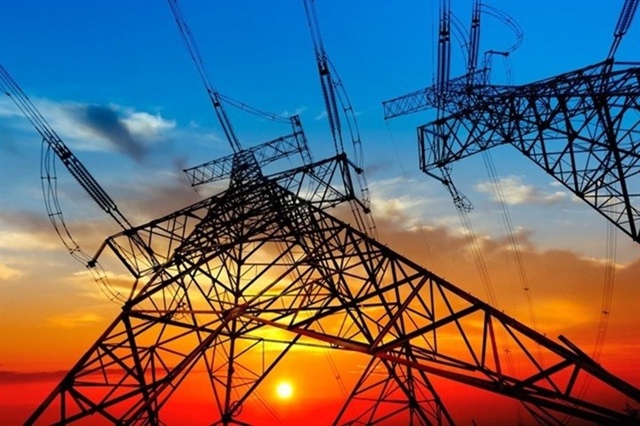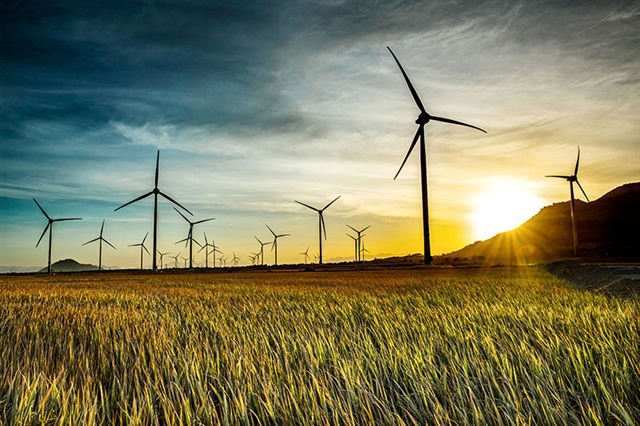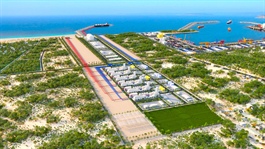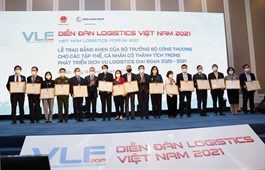Vietnam’s power plan to be submitted to PM in Q1/2022
Vietnam’s power plan to be submitted to PM in Q1/2022
The plan will be built with a focus on renewable energy and be in line with the national sustainable development after Vietnam pledged to cut greenhouse gas emissions to net-zero.
Vietnam’s Ministry of Industry and Trade (MoIT) has said it will submit the draft Power Development Planning VIII (PDP8) to the prime minister in the first quarter (Q1) this year.
Currently, the PDP8 is available for recommendations among localities nationwide before it will be finalized for submission, Bui Quoc Hung, Deputy Head of the MOIT’s Electricity & Renewable Energy Authority (EREA), said at a meeting last week.
Hung said the plan will focus on renewable energy and be in line with the national sustainable development after Vietnam pledged to cut greenhouse gas emissions to net-zero.
“The PDP8 dedicates a lot of space for the development of green, clean and environmentally friendly energy sources, with reasonable electricity production costs, in harmony with the interests of the state, investors, and electricity customers,” Hung noted.
Regarding localities’ request to add power generation projects, especially solar farms, to the national planning, Hung said the PDP8 cannot cover all suggested projects, but it maps out the regional planning to be suitable with the demand and transmission capacity in each zone.
Hung said in response to demand for developing renewables, mostly solar and wind power in areas like the central region and coastal provinces. Earlier, authorities in the central provinces of Ninh Thuan and Binh Thuan which have the highest solar irradiance in Vietnam have proposed to develop a number of solar projects.
As of 2020, Vietnam’s total generation capacity reached 69.3GW, including 16.5GW of solar power or 24% of the total capacity, 0.6GW of wind power, and more than 50% came from coal.

The power grid in Vietnam. Photo: EVN |
Roadmap for clean energy remains ahead
The PDP8 has been adjusted three times after its debut in March 2021. In the latest adjustment made in November 2021, the country’s power capacity by 2030 will be more than 155 gigawatts (GW) with a reduction by 24GW in coal-fired power.
Commenting on the latest version, Ngo Thi To Nhien, executive director of the Vietnam Initiative for Energy Transition (VIETSE), the first think tank in Vietnam specializing in energy transition and climate protection, said The MoIT has removed unfeasible coal-fired power projects but inserted all feasible liquified natural gas (LNG) projects.
The move somewhat makes LNG the key source for baseload generation capacity of the grid that could lead to high electricity prices or unstable caused by changes in the global fuel prices, To Nhien told The Hanoi Times.
PDP8 excluded floating solar farms while increasing a little bit wind power capacity. It added a pumped-storage hydropower plant but considers no battery energy storage systems (BESS) in the grid.
To Nhien said PDP8 has partially included amendments, however, it is hardly suitable or compatible with Vietnam’s goal of net-zero by 2050, in which it plans to have 48.5% of fossil fuel power in 2030 and 40.2% by 2045.
"The revision has not yet met the “least cost” and “national energy security” targets originally set forth because of a too high amount of newly-installed LNG capacity," Nhien said.
Carbon Tracker, an independent financial think tank providing in-depth analysis on investment in fossil fuels and the route to a low carbon future, said it is concerned about the financial risks implicitly embedded in the latest PDP8 draft. For example, MoIT projects 39.7GW of coal-fired power generation in 2030.
“According to our in-house modeling of net-zero by 2050, MoIT should instead prepare to keep just 6GW of coal power online in 2030, and a complete coal phaseout by 2040. This means no new coal power and a requirement to plan for the phaseout of existing coal”, said Durand D’souza, a data scientist at Carbon Tracker in the Power & Utilities team.
He said building new coal power plants and avoiding retirement of existing coal capacity will result in a disorderly energy transition, further asset stranding, and rising electricity costs, as the share of imported coal rises. Meanwhile, all 39.7GW of projected coal power capacity in 2030 will cost more to operate than building new onshore wind or solar PV capacity.
"Furthermore, MoIT should raise its expectations of offshore wind capacity significantly above 4GW and plan for a clean energy future with wind, solar, and hydropower at the core," D’souza said in an interview with The Hanoi Times
It is clear that MoIT recognizes the risks of building significant new LNG infrastructure when it cut new 2030 LNG capacity expectations in half. “However, we question the need for any LNG capacity which will make Vietnam’s electricity supply vulnerable to global gas price shocks such as those currently affecting Europe and East Asia,” D’souza warned.
"Avoiding a gas bridge, particularly one fueled by imported LNG, could bring significant savings, benefits, and economic stability to the country," he said.
It is essential that MoIT prioritizes new grid infrastructure and load-balancing capacity over new imported fossil fuel power plants in order to unlock significant savings in electricity costs and to avoid stranded asset risk, the expert emphasized.

Trung Nam wind farm in Ninh Thuan Province, Vietnam. Photo: Trungnam Group |
Meanwhile, Jacqueline Tao, Asia Expert at TransitionZero that supports the decline of fossil fuels and the shift to zero-carbon growth, said Vietnam’s net-zero ambition can only be achieved if it succeeds on its coal phase-out commitment. As a signatory to the Global Coal to Clean Power Transition pact, Vietnam has committed itself to stop building new coal plants. This is partially built into the latest discussions on PDP8, with no planned coal plants beyond 2025.
That being said, Vietnam still has a healthy pipeline of upcoming coal plants, which will add 18 GW of new coal-fired capacity by 2025, almost doubling the nation’s current coal fleet, Jacqueline Tao shared with The Hanoi Times.
In addition, the financial rationale for building new fossil fuel plants in the context of Vietnam’s climate ambitions is questionable. By 2040, Vietnam’s planned coal phase-out is achieved, these plants will have operated for just shy of two decades, with more than half of their technical lifetime ahead. Retiring such a young coal-fired power plant fleet will likely come at steep additional costs, she noted.
Regarding the vision, Deputy Prime Minister Le Van Thanh said Vietnam’s national power planning has been built at a slow pace compared to the requirements of the country’s economic development.
Management mechanisms on electricity prices and feed-in-tariff (FIT) show shortcomings and require in-depth research, Thanh said at the government meeting on January 9.
Among many, unreasonable power sources have led to huge investment in transmission networks, requiring approximately US$33 billion in the 2021-2030 period, compared to $12 billion in 2010-2020, he stated.
To meet requirements, the MoIT is making efforts and working with other ministries to make the PDP8 more reasonable and be in line with Vietnam’s emissions-cutting journey.


















